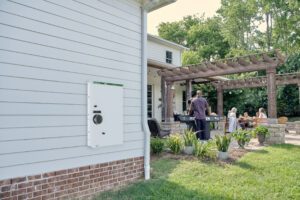
You may be surprised to learn that the on-off switch was not the starting point for adopting smart technology in the industrial sector. Historically, motor starters turned electric motors on and off, and overload relays protected motors from excess loading. And that’s been about it, even as Industry 4.0 has emerged to collect data from sensors, programmable logic controllers (PLCs), and embedded software.
But there is huge potential in applying smart technology to motor management, especially for original equipment manufacturers (OEMs), logistics, and at industrial sites with multiple motors in confined places. Digital motor control solutions can take data from asynchronous motors and loads to be properly incorporated into modern asset management strategies. Motor control management is a great foundation for 4.0 automation and leveraging the potential of the industrial internet of things (IIoT).
IIoT doesn’t only benefit end users. It also enables panel builders to supply their industrial manufacturing customers with state-of-the-art control panels that are needed to operate basic equipment, and automated and robotic systems. IIoT also increases production capabilities and profitability for their businesses. As a result, more industrial customers are acknowledging the benefits of integrated plant operations and are asking for motor control to be connected to asset management.
There are many benefits of integrating operations for Industry 4.0 adoption.
Digitizing motor control components, such as soft starters, variable speed drives, relays, and direct online starters, gives operators, maintenance staff, and plant managers the data and visibility they need to improve performance, reduce risk, and achieve higher-quality lifecycle support. In other words, it helps leverage data for practical solutions.
The promise of IIoT for motor management is realized through smart technology that helps:
- Operators with equipment operation alarms that either are managed by the equipment independent of the operator or that advise needed actions and provide relevant information.
- Maintenance technicians through equipment maintenance alarms that alert them to needed maintenance or provide troubleshooting details.
- Plant managers with equipment performance parameters that help manage usage and energy consumption.
- All benefit from connectivity that enables remote equipment monitoring.
Digitization also:
- Minimizes exposure to potential hazards by allowing personnel to perform preventive safety steps using touch-screen displays outside of flash boundaries.
- Gives the user more control in setting the time and conditions for maintenance activities as opposed to having to react to unplanned downtime.
- Reduces workarounds with control timers for complicated circuits.
The integration into asset management not only identifies potential failures, but it also helps operators make troubleshooting decisions based on performance data.
Innovations help companies fill voids that emerge from workforce issues.
Among the forces driving 4.0 adoption is the struggle for industrial and commercial operations to find skilled labor and technical expertise. Additionally, technicians who know how to take care of equipment are aging out. OEMs are increasingly interested in filling this void with monitoring and maintenance solutions for additional revenue following the sale of the machine. Recent motor control innovations are enabling a new means to simply and easily monitor motors driving key machine operations.
The TeSys™ island digital load management system by Schneider Electric™ monitors applications such as a pump, conveyor, or elevator. It can be easily configured to alarm if a motor goes outside of its normal band of operation range. It’s like a check engine light for the operator. Previously, a system wouldn’t tell the operator anything when an overload tripped, and even then, it would be up to a technician to diagnose why it happened.
Alarms can also be configured for a drop in motor current. Previously, motor controls only dealt with excess current over a duration of time, but they did nothing for scenarios where a drop in current occurs. This may not seem like a risk, but a drop in current can be serious for certain loads like pumps, which can burn out from inadequate flow. In other types of loads, a drop in motor current can indicate maintenance is necessary depending on the load type.
Innovative motor starters and circuit breakers enable smart applications.
Schneider Electric has reimagined its motor control devices to leverage digitization and IIoT. This will help OEMs reduce engineering time and complexity while improving machine reliability and decreasing maintenance costs.
The new TeSys Deca and Giga series motor starter innovations include options for a range of voltage choices and overload selections. They also have a QR code so operators can easily access specifications and documents to troubleshoot on-site more efficiently.
The Giga series has a PLC coil control input to help reduce the size of a power supply (where the control voltage is DC) and a transformer (where the control voltage is AC). The Giga series also has a higher level of preparedness. For example, a diagnostic LED on a contactor that looks at performance attributes and notifies when the contactor is down to 15% electrical operational life and when control voltage is out of the coil voltage tolerance.
While the TeSys Deca and Giga series offer an entry-level motor control method for equipment maintenance, the TeSys island provides much greater insight and ability to proactively manage the equipment operation and maintenance. TeSys island leverages alarms and data within the logic of the machine PLC to allow for localized access and greater operator/maintenance efficiency. This data can also be sent to the cloud for integration with EcoStruxure™ Machine Advisor, which makes it possible to use condition-based monitoring and predictive maintenance for motor controls.
The PowerPact™ line of molded case circuit breakers has been upgraded to operate more efficiently, show issues before they happen, and improve troubleshooting. The VisiTrip LED readout provides a window into real-time operations and makes it easier to see which circuit breaker has tripped in the enclosure or panel. It also has QR codes to access information such as the instruction manual, part numbers, and CAD drawings.
The TeSys and PowerPact equipment work well in so many different situations, that they will allow customers to reduce parts inventory.

Learn how a car wash solutions company leveraged IIoT to manage assets.
Like many OEMs, the car wash system industry was focused on how to manage power costs as opposed to a data-centric model of managing operations. Schneider Electric worked with Sonny’s® The CarWash Factory to develop a robust, yet user-friendly, custom smart motor control center (SMCC) to leverage the power of IIoT in operations. A local car wash was able to manage its assets through:
- Enhanced User Experience
- Faster installation and cloud maintenance
- Pinpoints anomalies and eliminates a lengthy troubleshooting process
- Automatic software updates
- Support – 7 days a week
- Consistent user experience across all devices
- New TeSys Island Technology
- Protects and manages motors and other electrical loads
- Gives operators easy, remote access to predictive and preventive data
- Provides data on alert history, motor performance, and energy consumption
- Easy Setup
- Configures the monitoring of specific performance parameters
- Sets VFD and Starter as specific device type
- Configurable from a touch screen or remotely
- Program functionalities such as timers, schedules, triggers, and sequences
- Secure System
- Assigns user logins to select employees
- Gated access to smart motor control center touch screen panel
- Automatic push of security updates
The SMCC allows Sonny’s to serve its customers beyond the initial purchase and install by offering useful data and replacement/maintenance services. This helps customers minimize downtime, which is a significant detractor for owners’ profitability.
Schneider Electric can be a go-to partner for your current and future needs.
To succeed, OEMs need partners that provide concepts for complete digitization, from the data acquisition level to edge control and cloud-to-asset management solutions. Leveraging IIoT will be a competitive advantage as capabilities create new ways to proactively monitor and manage equipment performance and operation, reducing unplanned downtime. IIot will make it easier to grow with opportunities for differentiating and developing new business models.
Schneider Electric provides 99% of the electrical components an OEM needs to easily and efficiently complete their offer so they can focus on sales and production. See how Schneider Electric can customize solutions for you, starting with your motor controls.
Scan the QR code or click the link to contact us today and learn more.




